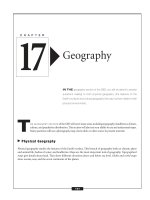4 1 4 the dine (social studies)
Bạn đang xem bản rút gọn của tài liệu. Xem và tải ngay bản đầy đủ của tài liệu tại đây (4.15 MB, 14 trang )
Suggested levels for Guided Reading, DRA,™
Lexile,® and Reading Recovery™ are provided
in the Pearson Scott Foresman Leveling Guide.
by Kathleen Cox
Genre
Expository
nonfiction
Comprehension
Skills and Strategy
• Author’s Purpose
• Compare and
Contrast
• Text Structure
Text Features
• Map
• Captions
• Glossary
Scott Foresman Reading Street 4.1.4
ISBN 0-328-13423-6
ì<(sk$m)=bdecdg< +^-Ä-U-Ä-U
Reader Response
1. Why do you think the author wrote this book?
Use a chart like the one below to help organize
your ideas.
Question the Author
1. What does the
author tell you?
2. Why do you think the
author tells you that?
3. Does the author say
it clearly?
4. What would make it
clearer?
5. How would you say
it instead?
by Kathleen Cox
2. The author organizes this book into four parts:
before Columbus; the Diné and the Spanish; the
Diné and the U.S. Army; the Diné today. Write a
sentence to tell about each part.
3. List two words from the Glossary and write
synonyms for them.
4. Look at the map on page 3. What is the northern
body of water? What is the southwestern body of
water?
Editorial Offices: Glenview, Illinois • Parsippany, New Jersey • New York, New York
Sales Offices: Needham, Massachusetts • Duluth, Georgia • Glenview, Illinois
Coppell, Texas • Ontario, California • Mesa, Arizona
Long before Christopher Columbus, there were
many groups of Native American people in North
America. Some scholars think that thousands of years
ago, their ancestors probably crossed from what is
now Russia into what we now call Alaska. At that
time a strip of land connected the two continents
where the Bering Strait is today. The Diné, who are
also known as the Navajo, were one of these groups
of Native Americans.
The Diné may have inhabited the land that is now
western Canada. They were hunters and gatherers.
Diné ancestors did not have horses. They hunted on
foot with spears and clubs. They also collected edible
flowers, leaves, and roots of wild plants for food.
Native American ancestors probably crossed from
Russia to Alaska where the Bering Strait is today.
Every effort has been made to secure permission and provide appropriate credit for
photographic material. The publisher deeply regrets any omission and pledges to
correct errors called to its attention in subsequent editions.
Unless otherwise acknowledged, all photographs are the property of Scott Foresman,
a division of Pearson Education.
Photo locators denoted as follows: Top (T), Center (C), Bottom (B), Left (L), Right (R),
Background (Bkgd)
Opener: Corbis Media, National Anthropological Archives; 5 Medio Images;
6 Medio Images, Brand X Pictures; 9 ©DK Images; 10 ©DK Images; 12 Corbis Media;
13 ©DK Images; 14 Getty Images; 16–17 Getty Images; 18 Getty Images; 20 AP/Wide
World; 22 Corbis Media
ISBN: 0-328-13423-6
Copyright © Pearson Education, Inc.
All Rights Reserved. Printed in the United States of America. This publication is
protected by Copyright, and permission should be obtained from the publisher
prior to any prohibited reproduction, storage in a retrieval system, or transmission
in any form by any means, electronic, mechanical, photocopying, recording, or
likewise. For information regarding permission(s), write to: Permissions Department,
Scott Foresman, 1900 East Lake Avenue, Glenview, Illinois 60025.
2 3 4 5 6 7 8 9 10 V0G1 14 13 12 11 10 09 08 07 06 05
3
The ancestors of the Diné were nomads. They
never stayed in one area for very long. Since the
Diné moved around, they had few possessions. They
carried little more than their weapons and the simple
tools they used for cooking. Too many possessions
would slow them down.
Because they understood that their survival
depended on the gifts of nature, the Diné might be
called early environmentalists. They protected and
respected the land. Never killing for sport, the Diné
hunted only to get food for themselves. Very little
of an animal was left behind. The Diné used animal
skins for clothing, animal bones to create jewelry and
weapons, and bird feathers for headgear.
The Diné’s religion and folklore celebrated nature.
They worshipped Father Sky and Mother Earth. They
revered the mountains, the rainbow, the Sun, the
rivers, and all animal species. Even plants were sacred
to the Diné.
Over time the Diné drifted south through the
Western plains. By the 1400s the Diné had migrated
to the southwestern part of what is now the United
States.
4
These carvings were found at the Canyon de Chelly
in Arizona, where the Diné lived.
Part of the Southwest was a desert grassland.
Though the area was very dry, part was covered with
evergreen forests. Another part was thick with berry
trees and nut trees. The Diné used the fibers of the
beautiful yucca plant to weave sandals and baskets.
Juniper and oak trees offered shade from the sun. The
nuts from the pinion tree were good food.
5
The Diné appreciated Mother Earth for all the wild
animals—the many bears, mountain lions, mountain
goats, elk, deer, rabbits, and raccoons. There were
lots of birds, including eagles and wild turkeys, and
plenty of fish in rivers.
In the Southwest the Diné discovered rivers and
streams and the beauty of the land. Majestic rock
formations stood like monuments inside huge canyons.
Towering cliffs rose up on either side of narrow
canyons. The beautiful land made the nature-loving
nomads want to stay in one place.
The Southwest was also home to other Native
Americans, including the Pueblo, who were farmers
and lived in villages. When the Diné met the Pueblo,
the Diné saw how these people benefited from
planting corn, squash, and beans in nearby fields.
These crops provided a steady source of food. The
Pueblo taught the Diné how to make pottery. They
showed them how to mix water into the clay dirt,
mold the mixture, and fire it to make useful pots,
containers, and tools.
Rock formations, Southwestern territory.>
Monument Valley, Arizona
Beans
6
7
The Diné learned the art of weaving from the
Pueblo, who wove cloth from the cotton that they
grew. The Diné used this cotton cloth to make more
comfortable clothing for the hot summers. During the
cold, snowy winters, the Diné continued to wear their
warm animal skins.
In the 1600s Spanish explorers came to the
Southwest. They traveled on powerful horses they
had brought from Spain.
The Diné saw the strength and speed of these
animals. They realized that it would be much easier to
hunt on horses. They could travel much faster. Horses
could also carry and pull heavy loads.
The Diné also admired the flocks of sheep that the
Spanish had brought from Spain. The Diné realized
that if they owned sheep, they would have a good
supply of food. They would not have to hunt every
day. The Diné decided they needed to get as many
horses and sheep from the Spanish as they could.
The Diné raided the Spanish settlements. In time
they became skilled raiders. They stole thousands of
animals for their herds. The Diné liked how much
these animals helped them in their everyday lives.
Raising livestock became important to the Diné.
8
9
The horse became the Diné’s preferred way to
travel, and sheep supplied much of their food. The
Diné wove the wool from the sheep into warm
blankets and rugs. In time the Diné became known
as first-class weavers. They also were first-class raiders
who raided other Native American settlements. Soon,
many people feared the Diné.
The Spanish stirred up their own trouble with
the Diné. The Spanish were devout Catholics. They
wanted to turn the Diné into Catholics, but the Diné
would not give up their sacred beliefs.
Fighting continued between the Diné and the
Spanish. So, in time, the Diné moved to a remote part
of the Southwest. They chose an area bordered by
four mountains that cut into the sky from each of the
four cardinal points. There was a towering peak in
the north, in the east, in the south, and in the west.
The Diné considered these four mountains sacred,
along with the land within their boundaries.
This area was also a good hiding place for the
Diné. Their scouts could conceal themselves behind
rocks jutting up from the canyons, or they could hide
out behind the rocky ledges on the top. When a
warrior spotted trouble, there was be plenty of time
to signal other Diné to warn of danger.
A Diné woman weaves a rug.
10
11
Once the Diné got horses and sheep, their lifestyle
changed. They continued to hunt, but now they
hunted on horseback. They needed a constant source
of food and water for the people and their herds.
The Diné farmed the surrounding land and grew
crops of corn, squash, and beans. The Diné also grew
splendid orchards of peach trees.
The Diné built hogans. Hogans were circular
structures supported by logs or poles and normally
covered with earth and bark. A fire was built inside
for both heat and cooking. A smoke hole in the top
of the hogan let smoke escape. The entrance to the
hogan always faced east so the Diné could honor and
greet the rising sun each morning. They lived in some
of the hogans, but other hogans were used only for
sacred ceremonies.
A Diné hogan
Peaks of La Plata Mountain (Dibé Nitsaa) in Colorado, one of
the four sacred mountains of Dinétah
The Diné called this rugged land Dinétah, or
homeland. For thousands of years small groups of
Diné had roamed North America. Usually, everyone
in each group was related. Once these small groups
moved to Dinétah, the Diné began to think of
themselves as a nation of people who shared a
common land.
12
13
In the 1800s the population of the United States
was expanding rapidly. People began settling in the
Southwest. Soon, the Diné discovered they had a new
rival: the U.S. cavalry and the American settlers.
The two groups battled each other off and on.
Then, in 1846, the Diné signed a peace treaty with
the U.S. government. Disagreements ended the peace
by 1849.
A new general, James Henry Carleton, took control
of the U.S. territory of New Mexico in 1862. The
general decided he disliked Native Americans.
U.S. cavalry chasing Native Americans
Portrait of Diné men
The general ordered Kit Carson, a famous trapper,
hunter, and frontier scout, to defeat the Diné. The
general told Carson that when the Diné surrendered
to him, they would be taken from their homeland.
Any Diné who didn’t agree to surrender would
be shot. The Diné soon discovered that they were
fighting for their survival.
Carson rode his troops into Canyon de Chelly in
Dinétah. Many Diné, who were starving, hid from
them behind the rocks.
14
15
The Diné threw stones and spears at the invaders,
but the cavalry had powerful rifles. The Diné could
not stop their rivals from destroying the last of their
peach trees and fields of corn, squash, and beans.
They could not stop the destruction of their herds.
The Diné were overwhelmed and weak from many
days with little food. They were exhausted from so
many battles with the American soldiers. They were
freezing from the harsh winter cold.
By the end of 1864, thousands of Diné had
surrendered to the U.S. Army. Long lines of Diné men,
women, and children walked about three hundred
miles to Fort Sumner in New Mexico. The cavalry
watched every step.
Many Diné died from starvation, illness, and
exhaustion during the march, called the Long Walk.
It took at least forty days for the Diné to get to Fort
Sumner.
Once the Diné reached their new reservation, they
continued to suffer. They tried to farm the new land,
but the soil was poor. The weather was not much
better. Part of the year brought no rain and too much
sun, which dried out the land. The other part of the
year brought floods from too much rain.
In four years, 25 percent of the Diné died from
hunger and disease. The Diné who managed to
survive those difficult years at Fort Sumner longed to
return to their sacred homeland.
U.S. soldiers stand watch over
the captured Diné at Fort Sumner.
16
17
The U.S. government finally let the Diné sign a
second peace treaty in 1868. In return the Diné were
given land in the Southwest. Their new reservation
included their sacred Dinétah. The Diné were also
given some livestock to replace what had been taken.
They were given the right to make their own laws on
this new reservation. Their days of raiding were over.
The Diné had to promise to keep the peace, and they
could no longer fight against the U.S. government.
The cavalry had destroyed Dinétah. Weeds grew
throughout the once-plowed fields, dirt filled the
ditches where water once flowed, and the lovely
peach trees were reduced to tree stumps. But the
Diné still had their four sacred mountains.
The Diné wanted to repair the damage. They
performed ceremonies in honor of their Mother Earth.
They prayed that Mother Earth would bless them
again. Over time the Diné made a comeback. By 1890
their population had doubled to eighteen thousand
people. The Diné also increased the size of their
reservation until they owned more than fifteen million
acres of land. Most of their land is in New Mexico and
Arizona. The Diné also built up their livestock.
Diné women weaving on their reservation
18
19
In the 1940s the Diné joined forces with the
people who once captured them. More than three
thousand Diné became members of the U.S. military
during World War II. Many of them trained to
become Code Talkers. The Code Talkers were Marines
stationed in the Pacific.
The Code Talkers did not fight with guns. They fought
with their language. The Diné sent important secret
messages to other Marines so that they could defeat the
Japanese. The Japanese, who had skilled code-breakers,
could not understand the secret Diné code.
Since World War II, the Diné nation has worked
to create new opportunities for its people and the
country. The Diné are allowing oil wells on their land,
and already companies are searching for valuable
minerals.
The Diné teach their children to respect their
culture, and they want them to know the Diné
nation’s history. They want them to learn their
language and to revere their land and traditions—to
have a respect for the old teachings. People across
America also have learned to respect and understand
the Diné culture, as it is a special part of our diverse
country.
World War II Code Talkers
20
21
Now Try This
Be a First-Class Weaver
The Diné are known for their beautiful weaving
work. As you know, they wove cotton into cool
clothing and wool into warm blankets and rugs. The
skilled art of weaving is an important part of the Diné
culture. Their artistry represents who they are as a
people. You can be a first-class weaver too!
Diné woven blanket
22
to Do It!
w
o
H
s
’
e
r
He
1. Find two same-sized pieces of construction paper
in two of your favorite colors.
2. Cut one piece of paper into one-inch-wide strips
going the long way, shown in example A. Cut
the other piece of paper into one-inch-wide strips
going the short way, shown in example B, leaving
the last inch of the strip connected to the paper.
This will be your base to start weaving.
3. Weave the strips of the first piece of paper over
and under the strips of the second piece of paper.
If one row begins by going “over,” then the next
row should begin by going “under.” This will
create your pattern. You may want to use small
pieces of tape on the last strip to keep it in place.
4. Try experimenting with thinner or wider strips. Try
different colors to make unique designs. Decorate
your woven art with symbols that represent who
you are as a person.
A
B
23
Glossary
Reader Response
ancestors n. people
from whom you are
descended, such as your
great-grandparents.
hogans n. circular
buildings, made from
logs and earth, used by
the Diné.
cardinal points n. an
expression for the four
principal directions on
the compass: north,
south, east, and west.
inhabited v. lived in a
place.
edible adj. something
that is safe to eat.
environmentalists n.
people who want to
protect the land.
nomads n. people who
move from place to
place.
1. Why do you think the author wrote this book?
Use a chart like the one below to help organize
your ideas.
Question the Author
1. What does the
author tell you?
2. Why do you think the
author tells you that?
3. Does the author say
it clearly?
4. What would make it
clearer?
5. How would you say
it instead?
2. The author organizes this book into four parts:
before Columbus; the Diné and the Spanish; the
Diné and the U.S. Army; the Diné today. Write a
sentence to tell about each part.
3. List two words from the Glossary and write
synonyms for them.
4. Look at the map on page 3. What is the northern
body of water? What is the southwestern body of
water?
24









